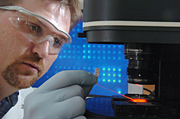- Number 309 |
- April 12, 2010
Schabaker: Bioterror sleuth

Biochemist Daniel Schabacker
Biochemist Daniel Schabacker of DOE's Argonne National Laboratory could be considered a Sherlock Holmes of bioterrorism. Although he doesn’t carry around a pipe and magnifying glass as he attempts to nab the culprit, he has a far more powerful deductive tool: the biochip.
The biochip offers Schabacker and his colleagues at Loyola University (Ill.) a chance to determine the “signatures” of biological agents that can be used for bioterrorism, most notably the bacterium that causes anthrax, Bacillus anthracis. While some scientists have used DNA analysis to identify particular strains of the anthrax bacterium, the biochips help scientists and government officials to learn how anthrax bacteria are grown, narrowing the pool of potential suspects. This project, started only within the past couple of years, exemplifies the burgeoning field of microbial forensics.
"Microbial forensics is one of the biggest topics in counterterrorism today, and one of the biggest challenges in dealing with bioterrorism,” Schabacker said. "The proteomic analysis that we’re able to perform with our biochips provides a new and different set of information about biological agents than we’d been able to see before; it can provide us with a complete fingerprint of the organism that we can then use to more precisely identify its origin.”
According to Schabacker, most efforts in microbial forensics today rely on DNA analysis for their findings. But on its own, Schabacker said, DNA analysis may not be sufficient to give investigators all the information they need about a particular bioagent. “The problem with only using conventional DNA analysis is that it only tells you what strain you are dealing with, and strains used by the good guys can be obtained by our enemies. There can be dozens of labs that all share the same strain,” he said. “Our approach attacks the problem in a completely different way. We take advantage of the fact that unlike cellular DNA, bacterial proteins change dramatically when the growth or preparation of the bacterial culture is altered — and that information is incredibly important.”
Because the anthrax bacterium’s proteins hold a unique and detailed record of how the cells were generated and handled, Schabacker believes that pursuing DNA and protein analyses in concert could yield a comprehensive database that identifies the conditions used to prepare almost any B. anthracis culture.
Developed in the early part of the decade originally as a diagnostic tool, a biochip consists of a one-centimeter by one-centimeter array that contains anywhere between several dozen and several hundred "dots," or small drops. Each of these drops contains a unique protein, antibody or nucleic acid that will attach to a particular reagent.
Scientists obtain the anthrax proteins to create the biochip through a process called fractionation. Essentially, the scientists use chemicals to break open the anthrax bacterium and collect its cellular proteins. They then use another process to separate the individual proteins by their physiochemical properties.
This process creates hundreds of separate protein fractions, which are then deposited onto a single biochip. Scientists then use different chemicals, or reagents, to characterize the resulting biochips just as a detective would dust for fingerprints. Just like a police interview with a suspect, this chemical process is known as “interrogation.” When a reagent interacts with a particular protein fraction, that spot will “light up,” creating part of the protein signature.
Submitted by DOE's Argonne National Laboratory
